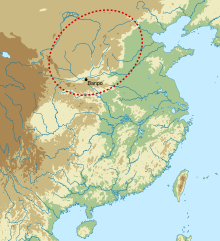Yangshao
 |
|||||||
| Geographical range | Loess Plateau | ||||||
|---|---|---|---|---|---|---|---|
| Period | Neolithic | ||||||
| Dates | c. 5000 – c. 3000 BC | ||||||
| Major sites | Banpo, Jiangzhai | ||||||
| Preceded by | Peiligang culture, Dadiwan culture, Cishan culture | ||||||
| Followed by | Longshan culture | ||||||
| Chinese name | |||||||
| Chinese | 仰韶文化 | ||||||
|
|||||||
| Transcriptions | |
|---|---|
| Standard Mandarin | |
| Hanyu Pinyin | Yǎngsháo wénhuà |
The Yangshao culture was a Neolithic culture that existed extensively along the Yellow River in China. It is dated from around 5000 BC to 3000 BC. The culture is named after Yangshao, the first excavated representative village of this culture, which was discovered in 1921 in Henan Province by the Swedish archaeologist Johan Gunnar Andersson (1874–1960). The culture flourished mainly in the provinces of Henan, Shaanxi and Shanxi.
The main food of the Yangshao people was millet, with some sites using foxtail millet and others broom-corn millet, though some evidence of rice has been found. The exact nature of Yangshao agriculture, small-scale slash-and-burn cultivation versus intensive agriculture in permanent fields, is currently a matter of debate. Once the soil was exhausted, residents picked up their belongings, moved to new lands, and constructed new villages. However, Middle Yangshao settlements such as Jiangzhi contain raised-floor buildings that may have been used for the storage of surplus grains. Grinding stones for making flour were also found.
The Yangshao people kept pigs and dogs. Sheep, goats, and cattle are found much more rarely. Much of their meat came from hunting and fishing. Their stone tools were polished and highly specialized. They may also have practiced an early form of silkworm cultivation.
The Yangshao culture crafted pottery. Yangshao artisans created fine white, red, and black painted pottery with human facial, animal, and geometric designs. Unlike the later Longshan culture, the Yangshao culture did not use pottery wheels in pottery-making. Excavations found that children were buried in painted pottery jars.
The Yangshao culture produced silk to a small degree and wove hemp. Men wore loin cloths and tied their hair in a top knot. Women wrapped a length of cloth around themselves and tied their hair in a bun.
...
Wikipedia
